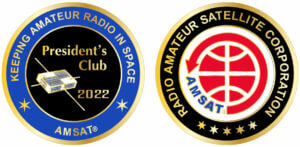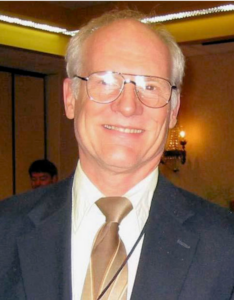AMSAT NEWS SERVICE
ANS-121
The AMSAT News Service bulletins are a free, weekly news and information service of AMSAT, The Radio Amateur Satellite Corporation. ANS publishes news related to Amateur Radio in Space including reports on the activities of a worldwide group of Amateur Radio operators who share an active interest in designing, building, launching and communicating through analog and digital Amateur Radio satellites.
The news feed on http://www.amsat.org publishes news of Amateur Radio in Space as soon as our volunteers can post it.
Please send any amateur satellite news or reports to: ans-editor [at] amsat.org
You can sign up for free e-mail delivery of the AMSAT News Service Bulletins via the ANS List; to join this list see: https://mailman.amsat.org/postorius/lists/ans.amsat.org/
In this edition:
- AMSAT Hamvention Update
- AMSAT Represented at the 2022 CubeSat Developers Workshop
- FO-29 Now Eclipsing, Upcoming Operations Schedule Posted
- ARISS News
- Upcoming Satellite Operations
- Hamfests, Conventions, Maker Faires, and Other Events
- Satellite Shorts From All Over
ANS-121 AMSAT News Service Weekly Bulletins
To: All RADIO AMATEURS
From: Radio Amateur Satellite Corporation
712 H Street NE, Suite 1653
Washington, DC 20002
DATE 2022 May 1
AMSAT Hamvention Update
The Dayton Hamvention is just three weeks away! It is time to be creating your shopping list and making your travel plans. AMSAT’s presence will be felt in with eight adjoining booths in Building 1. Highlighting the exhibit will be:
– CubeSat Simulator hardware and software demonstrations
– SatPC software demonstrations
– AMSAT Engineering staff question and answer table
– AMSAT Youth Initiative (KidzSat) introduction
– OSCAR ground station for live satellite operations
– Annual Membership sign-up and renewals
– AMSAT President’s Club recognition
– AMSAT Board of Directors and Senior Officers Meet and Greet
– AMSAT Store offering AMSAT trinkets, books and Arrow Antennas
In past years, we had 30 people assist with the AMSAT booth at Dayton. We’ve had a good response so far to our call for volunteers, but we could really use another 10-15 people. The 2022 Hamvention is May 20-22 in Xenia, Ohio. Would you consider helping AMSAT at the Hamvention this year?
The interaction with AMSAT members, satellite operators, designers, and builders makes the whole experience a lot of fun. Meet or renew acquaintances, exchange operating tips, and find out what antennas, software and equipment other AMSAT members use. We currently expect the AMSAT senior officers and board members to be there too.
If you’re an experienced operator, great! We can use you and your experience.
If you’ve never operated a satellite before, but want to learn more, that’s OK. We can use your help too.
Whether you’re available for only a couple of hours or if you can spend the entire weekend with us, your help would be greatly appreciated. Please send an e-mail to Phil, (w1eme[at]amsat[dot]org if you can help. Thank you!
AMSAT/TAPR Banquet will honor the life of Bob Bruninga, WB4APR
The 13th annual AMSAT/TAPR Banquet will be held at the Kohler Presidential Banquet Center on Friday, May 20th at 18:30 EDT. This dinner is always a highlight of the AMSAT (Radio Amateur Satellite Corp.) and TAPR (Tucson Amateur Packet Radio) activities during the Dayton Hamvention. This year’s banquet will honor the life and accomplishments of long time amateur satellite and amateur packet pioneer Bob Bruninga, WB4APR, who passed away in February.
The Kohler Presidential Banquet Center is located at 4548 Presidential Way, Kettering, Ohio. That is about 20 minutes away from the Greene County Fairgrounds.
Tickets ($57 each) may be purchased from the AMSAT store. The banquet ticket purchase deadline is Friday, May 13th. Banquet tickets must be purchased in advance and will not be sold at the AMSAT booth. There will be no tickets to pick up at the AMSAT booth. Tickets purchased on-line will be maintained on a list with check-in at the door at the banquet center. Seating is limited to the number of meals reserved with the Kohler caterers based on the number of tickets sold by the deadline.
Register today at https://www.amsat.org/product/amsat-tapr-joint-hamvention-banquet-registration/
[ANS thanks Phil Smith, W1EME, AMSAT Hamvention Team Leader, AMSAT News & TAPR for the above information]
+=+=+=+=+=+=+=+=+=+=+=+=+=+=+=+=+=+=+=+=+=+=+=+=+=+=+=+=+=+=+=+=+=+=+

The 2022 AMSAT President’s Club coins have arrived!
To commemorate the 50th anniversary of its launch on
October 15, 1972, this year’s coin features
an image of AMSAT-OSCAR 6.
Join the AMSAT President’s Club today and help
Keep Amateur Radio in Space!
https://www.amsat.org/join-the-amsat-presidents-club/
+=+=+=+=+=+=+=+=+=+=+=+=+=+=+=+=+=+=+=+=+=+=+=+=+=+=+=+=+=+=+=+=+=+=+
AMSAT Represented at the 2022 CubeSat Developers Workshop
The 2022 CubeSat Developers Workshop was held in person for the first time since 2019 on the campus of California Polytechnic State University in San Luis Obispo, California on April 26th-28th. AMSAT hosted an exhibitor booth at the event and was represented by Vice President – Engineering Jerry Buxton, N0JY, and Assistant Vice President – Engineering Jonathan Brandenburg, KF5IDY.
During the event, discussions were held with students and others developing CubeSats about educational partnership opportunities, AMSAT’s LTM-1 linear transponder communications system as an option for their RF, and volunteer opportunities with AMSAT.
AMSAT also met with officials from NASA’s Launch Services Program (LSP) regarding options and possibilities for future GOLF missions above LEO.
Stay tuned for more updates in a future Engineering Update column in The AMSAT Journal.
[ANS thanks AMSAT Vice President – Engineering Jerry Buxton, N0JY, for the above information]
+=+=+=+=+=+=+=+=+=+=+=+=+=+=+=+=+=+=+=+=+=+=+=+=+=+=+=+=+=+=+=+=+=+
Need new satellite antennas? Purchase Arrows, Alaskan Arrows,
and M2 LEO-Packs from the AMSAT Store. When you purchase through
AMSAT, a portion of the proceeds goes towards
Keeping Amateur Radio in Space.
https://amsat.org/product-category/hardware/
+=+=+=+=+=+=+=+=+=+=+=+=+=+=+=+=+=+=+=+=+=+=+=+=+=+=+=+=+=+=+=+=+=+
FO-29 Now Eclipsing, Upcoming Operations Schedule Posted
Regarding Fuji 3 (FO-29), we are currently in a situation where continuous operation is not possible as the satellite is eclipsing on every orbit and the condition of the batteries does not permit continuous operation. From now on, we will enter the eclipse period for about 3 months. It will be fully sunlit from August to next spring, so continuous operation will be possible.
This eclipse period is about 3 months, and the maximum eclipse percentage is about 20%.
The operation from the end of April to the end of May will from when the analog transponder is turned on until the transponder is turned off by UVC (undervoltage control).
[Scheduled time to turn on the analog transponder of Fuji 3 (UTC)]
May
1 09:55
7 09:45
8 08:45
14 10:18
21 09:10 22:00
22 09:55
27 23:28
28 09:35
[ANS thanks JARL for the above information]
ARISS News
No contacts currently scheduled
Axiom AX-1 back on earth
Congratulations on a job well done!
Michael López-Alegría
Larry Connor
Mark Pathy KO4WFH
Eytan Stibbe 4Z9SPC
The USOS ARISS station is currently operating in voice cross-band repeater mode
The latest information on the operation mode can be found at https://www.ariss.org/current-status-of-iss-stations.html
The latest list of frequencies in use can be found at https://www.ariss.org/contact-the-iss.html
[ANS thanks Charlie Sufana, AJ9N, one of the ARISS operation team mentors, for the above information]
+=+=+=+=+=+=+=+=+=+=+=+=+=+=+=+=+=+=+=+=+=+=+=+=+=+=+=+=+=+=+=+=+=+
AMSAT, along with our ARISS partners, is developing an Amateur
Radio package, including two-way communication capability, to
be carried on-board Gateway in lunar orbit.
Support AMSAT’s projects today at https://www.amsat.org/donate/
+=+=+=+=+=+=+=+=+=+=+=+=+=+=+=+=+=+=+=+=+=+=+=+=+=+=+=+=+=+=+=+=+=+
Upcoming Satellite Operations
WL7T: EL84, June 24-27
W3IPA: DM42 vacation planned for Jul 30- Aug 6th will be on FM passes vacation style. I will be close to DM41 so might be able to work a gridline. Will post more updates closer to that week!
ND9M/MM: I’m on my merchant marine ship anchored just off Saipan and expect to be here a few weeks. I’m on from the ship as ND9M/MM in QK25, but I’ll try to be QRV as ND9M/KHØ from the island itself over the next few weekends, probably Fridays in the afternoon and evening, possibly Saturday evenings as well. I’ll post my island activities on Twitter (@ND9M) as they firm up
N8MR: EN 57,67,56 8/6 through 8/13. More to come as date gets closer.
Hawaii!: K5ZM is heading to HI on May 16-26
[ANS thanks Paul Overn, KE0PBR, AMSAT rover page manager, for the above information]
Hamfests, Conventions, Maker Faires, and Other Events
AMSAT Ambassadors provide presentations, demonstrate communicating through amateur satellites, and host information tables at club meetings, hamfests, conventions, maker faires, and other events.
+ Hamvention 2022
May 20, 2022 to May 22, 2022
Greene County Fairgrounds and Expo Center
210 Fairground Road
Xenia, Ohio 45385
https://www.hamvention.org
+ 2022 Rocky Mountain ARRL Division Convention
October 7, 2022 – October 9, 2022
Event Center at Archer
3921 Archer Pkwy
Cheyenne, Wyoming 82007
https://wyhamcon.org/site
[ANS thanks Paul Overn, KE0PBR, AMSAT Events page manager, for the above information]
+=+=+=+=+=+=+=+=+=+=+=+=+=+=+=+=+=+=+=+=+=+=+=+=+=+=+=+=+=+=+=+=+=+
Want to fly the colors on your own grid expedition?
Get your AMSAT car flag and other neat stuff
from our Zazzle store!
25% of the purchase price of each product goes
towards Keeping Amateur Radio in Space
https://www.zazzle.com/amsat_gear
+=+=+=+=+=+=+=+=+=+=+=+=+=+=+=+=+=+=+=+=+=+=+=+=+=+=+=+=+=+=+=+=+=+
Satellite Shorts From All Over
+ On April 28th, DO-64 (Delfi-C3) celebrated 14 years of operation in orbit. Although the linear transponder failed several years ago, the satellite continues to transmit telemetry. [ANS thanks DelfiSpace for the information]
+ The Netflix show Yakamoz S-245 features a mission control room. On one of the PC screens, both the FUNcube Dashboard and SatPC32 are visible. [ANS thanks 2M0SQL and PA3WEG for the information]
+ The SpaceX Crew-4 mission arrived at the International Space Station at 23:37 UTC on April 27, 2022 with Kjell Lindgren, KO5MOS, Robert Hines, KI5RQT, Samantha Cristoforetti, IZ0UDF, and Jessica Watkins on board. [ANS thanks NASA for the information]
Join AMSAT today at https://launch.amsat.org/
In addition to regular membership, AMSAT offers membership to:
* Societies (a recognized group, clubs or organization).
* Primary and secondary school students are eligible for membership at one-half the standard yearly rate.
* Post-secondary school students enrolled in at least half time status shall be eligible for the student rate for a maximum of 6 post-secondary years in this status.
* Memberships are available for annual and lifetime terms.
Contact info [at] amsat.org for additional membership information.
73 and remember to help Keep Amateur Radio in Space!
This week’s ANS Editor,
Paul Stoetzer, N8HM
n8hm at amsat dot org

